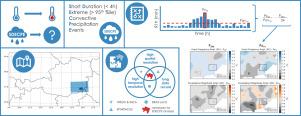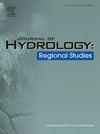从区域到地方尺度探讨气候变化对东南阿尔卑斯山前缘地区暖季极端降水的可能放大作用
IF 4.7
2区 地球科学
Q1 WATER RESOURCES
引用次数: 0
摘要
研究区域:阿尔卑斯山东南部前缘地区,研究的代表性区域主要位于奥地利东南部。研究重点:短时极端对流降水事件(SDECPEs)越来越多地受到气候变化的影响,但ERA5-Land 等再分析数据集无法正确探测到此类事件。韦格纳网(WEGN)高密度台站网络和奥地利 GeoSphere 的 INCA 数据集提供了更高的分辨率,使其更适合于研究,但它们只能提供最近二十年的数据。因此,在本研究中,我们利用 WegenerNet 和 INCA 数据对暖季(4 月至 10 月)SDECPE 进行了高分辨率勘测,并结合 1961-2022 年的(再)分析数据,评估了气候变化可能导致的这种亚日极端降水的扩大。我们为此编制了 SDECPE 分类,并采用了一类新的阈值-超标量(TEA)指标进行长期分析。对该地区的新水文见解:尽管每小时尺度的极端降水量预计会随着气温升高而增加,但我们发现该地区的局部尺度差异很大。一些次区域显示出比克劳修斯-克拉皮隆关系所显示的更高的增幅,并且超出了估计的自然变率,而另一些次区域则显示出极端降水量的减少。最大小时降水量和平均小时降水量之间的检测比率以及 TEA 指标使人们能够更深入地了解这些极端降水量的变化。这也有力地证明了长期高分辨率降水观测的重要性。本文章由计算机程序翻译,如有差异,请以英文原文为准。

Exploring possible climate change amplification of warm-season precipitation extremes in the southeastern Alpine forelands at regional to local scales
Study Region:
Southeastern Alpine forelands, with the representative regions explored mainly located in Southeast Austria.
Study Focus:
Short duration extreme convective precipitation events (SDECPEs) are increasingly altered by climate change but such events are not properly detectable in reanalysis datasets like ERA5-Land. Data from the WegenerNet (WEGN) high-density station network and GeoSphere Austria’s INCA dataset provide higher resolution, making them more suitable for the investigation, but are available only for the most recent two decades. In this study we hence leverage the WegenerNet and INCA data for the high-resolution exploration of warm-season (Apr–Oct) SDECPEs and assess, through combination with (re)analysis data over 1961–2022, a potential climate-change-induced amplification of such sub-daily precipitation extremes. We prepared a SDECPE classification to this end and employ a new class of threshold-exceedance-amount (TEA) metrics for the long-term analysis.
New hydrological insights for the region:
Even though extreme hourly-scale precipitation is expected to increase with rising temperatures, we find that this strongly varies at local scales within the region. While some subregions show an amplification higher than the Clausius–Clapeyron relation would suggest, and beyond estimated natural variability, others exhibit a decrease in extreme precipitation. The inspected ratios between maximum and average hourly precipitation and the TEA metrics enabled deeper insights into the changes of these extremes. Also the vital need for long-term high-resolution precipitation observations was strongly evidenced.
求助全文
通过发布文献求助,成功后即可免费获取论文全文。
去求助
来源期刊

Journal of Hydrology-Regional Studies
Earth and Planetary Sciences-Earth and Planetary Sciences (miscellaneous)
CiteScore
6.70
自引率
8.50%
发文量
284
审稿时长
60 days
期刊介绍:
Journal of Hydrology: Regional Studies publishes original research papers enhancing the science of hydrology and aiming at region-specific problems, past and future conditions, analysis, review and solutions. The journal particularly welcomes research papers that deliver new insights into region-specific hydrological processes and responses to changing conditions, as well as contributions that incorporate interdisciplinarity and translational science.
 求助内容:
求助内容: 应助结果提醒方式:
应助结果提醒方式:


